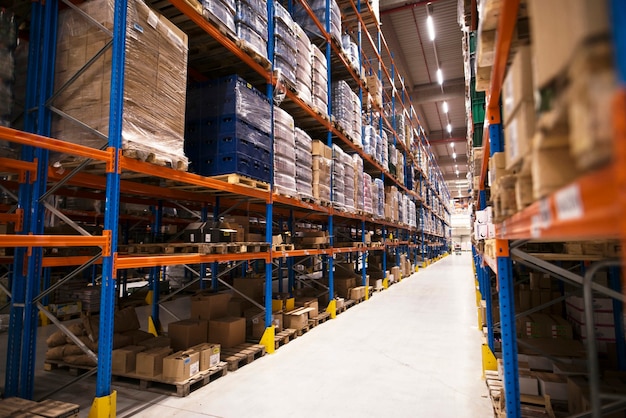
Efficient warehouse management is crucial for businesses in the UAE that handle inventory, logistics, and distribution. One of the key components of a well-organized storage system is warehouse rack labels. These labels help in streamlining operations, improving inventory accuracy, and reducing human errors. Whether you run a small storage facility or a large distribution center, implementing a proper labeling system ensures seamless workflow and better space utilization.
Warehouse rack labels in UAE are essential for tracking products, managing stock levels, and facilitating quick retrieval of items. By using barcode labels, magnetic labels, or adhesive labels, businesses can optimize their warehouse layout and reduce the time spent searching for inventory. In a region like the UAE, where industries such as retail, e-commerce, and manufacturing rely heavily on warehousing, an efficient labeling system becomes even more critical. This article explores the importance, types, and benefits of warehouse rack labels and best practices for their implementation.
Importance of Warehouse Rack Labels
A structured warehouse labeling system enhances efficiency and ensures that workers can quickly locate and manage inventory. Here’s why warehouse rack labels are essential:
1. Enhanced Inventory Management
Warehouse rack labels improve stock visibility and help businesses track product movement accurately. This reduces the chances of misplaced inventory and stock discrepancies.
2. Faster Order Fulfillment
With clearly labeled racks, warehouse staff can locate products swiftly, reducing picking and packing time. This leads to improved order accuracy and faster deliveries.
3. Minimized Errors
Misplacing items or picking the wrong products can cause delays and financial losses. Rack labels help prevent such errors by providing clear identification of stored goods.
4. Better Space Utilization
An organized warehouse allows businesses to maximize storage space. Proper labeling ensures that every rack and shelf is used efficiently, preventing clutter and confusion.
5. Improved Workplace Safety
Labeling ensures that employees can navigate the warehouse safely without confusion. This minimizes accidents and enhances compliance with warehouse safety regulations in the UAE.
Types of Warehouse Rack Labels
Different warehouses require different types of labeling solutions based on their storage conditions, industry type, and operational requirements. Below are some common types of warehouse rack labels used in the UAE:
1. Barcode Labels
Barcode labels are widely used for automated inventory management. Scanning these labels with handheld devices speeds up inventory tracking and reduces manual errors.
2. Magnetic Labels
These labels are perfect for warehouses with frequently changing stock. They can be easily repositioned without damaging the shelving, making them ideal for dynamic storage environments.
3. Adhesive Labels
Permanent adhesive labels are best suited for long-term labeling needs. They stick securely to racks and shelves, ensuring that labels remain in place even in high-traffic areas.
4. Color-Coded Labels
Color-coded labeling enhances visibility and organization. Different colors can indicate product categories, storage zones, or priority levels.
5. Floor Labels
Used in conjunction with rack labels, floor labels mark designated pathways, storage sections, and heavy machinery zones, further improving warehouse navigation.
Best Practices for Implementing Warehouse Rack Labels
To maximize the benefits of rack labeling, businesses should follow these best practices:
1. Choose the Right Label Material
Select materials based on warehouse conditions. For example, weatherproof labels are ideal for cold storage, while heat-resistant labels work well in high-temperature environments.
2. Use a Standardized Labeling Format
Ensure consistency in label size, font, and barcode format to maintain clarity and uniformity across the warehouse.
3. Position Labels Correctly
Labels should be placed at eye level or in a clearly visible position to facilitate easy scanning and reading by warehouse staff.
4. Regularly Update and Maintain Labels
Warehouse layouts and inventory categories may change over time. Regularly updating and replacing damaged or outdated labels keeps the system efficient.
5. Train Employees on Labeling Systems
Workers should be trained on how to read and use rack labels effectively. This ensures smooth warehouse operations and minimizes confusion.
Benefits of Warehouse Rack Labels in UAE
1. Increased Productivity
A well-organized warehouse ensures that employees spend less time searching for items and more time fulfilling orders.
2. Cost Savings
Reducing errors, minimizing misplaced inventory, and optimizing warehouse space leads to significant cost savings for businesses.
3. Improved Customer Satisfaction
Faster and more accurate order processing results in timely deliveries, enhancing customer experience.
4. Compliance with Industry Standards
Many businesses in the UAE must comply with warehouse safety and inventory management regulations. Rack labeling helps meet these standards effortlessly.
Conclusion
Warehouse rack labels in UAE play a vital role in ensuring efficient inventory management, improved organization, and increased productivity. Whether using barcode labels, magnetic labels, or color-coded labels, businesses can optimize warehouse operations and streamline workflows. By implementing a well-structured labeling system and following best practices, warehouses can reduce errors, improve efficiency, and enhance workplace safety.